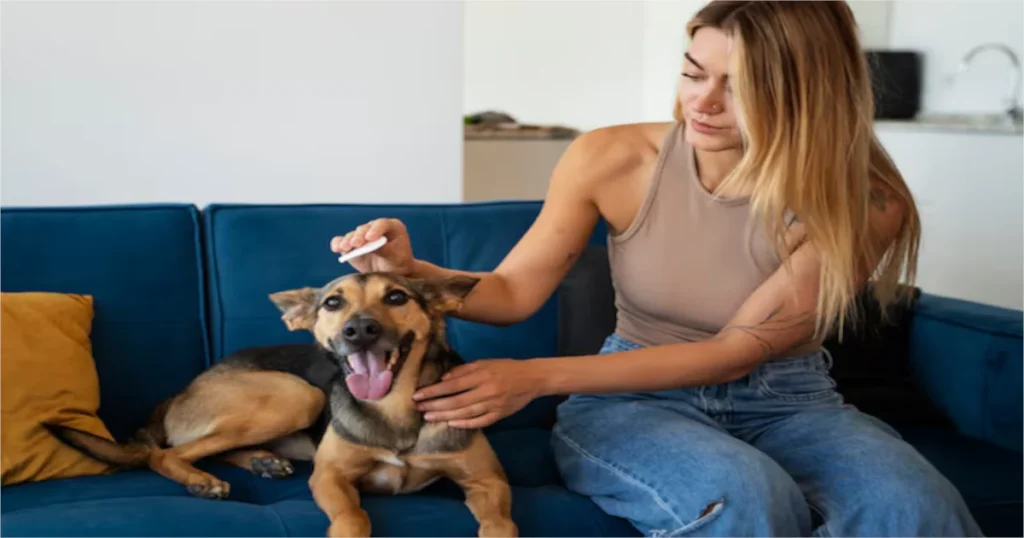Article Summary
Fleas are a common problem for dogs, but how do they get them? Fleas can latch onto your pet in various ways, from direct contact with infected animals to exposure in areas with high flea populations. Understanding how fleas spread helps you prevent infestations and protect your dog’s health. In this article, we will explore the different ways dogs get fleas, how to spot the signs of an infestation, and effective treatments to help get rid of fleas for good. Keep reading to learn everything you need to know about protecting your dog from these pesky parasites.
Introduction: How Dogs Get Fleas
Fleas are tiny, wingless insects that often infest dogs, leading to discomfort and potential health risks. If you’ve ever wondered how dogs get fleas, the answer involves several methods of transmission. Fleas can hop from one host to another, often traveling through the environment. Dogs are especially vulnerable if they come into contact with other animals or places where fleas thrive. The need to address flea infestations quickly is critical for your dog’s well-being. This article will guide you through the various ways dogs get fleas and how you can prevent these unwelcome pests from causing harm.
How Dogs Get Fleas: Main Causes of Infestation
1. Direct Contact with Infected Animals
One of the most common ways dogs get fleas is by coming into contact with other infected animals. Fleas can easily jump from one dog or animal to another, using the animal as a host. Dogs that interact with outdoor animals, such as stray dogs, cats, or wildlife, are particularly at risk. Fleas are quick to latch onto any fur they can find, often hopping onto your pet without you noticing.
2. Exposure to Flea-Infested Environments
Dogs can pick up fleas simply by walking through flea-infested areas. Fleas live in grass, yards, parks, or any area with dense vegetation. If your dog walks through an environment where fleas are present, they can hop onto your pet, hitching a ride back home. Areas like kennels, grooming salons, or pet stores also have a higher chance of fleas being present.
3. Poor Hygiene and Living Conditions
Dogs that are kept in unsanitary environments are more likely to pick up fleas. Fleas thrive in places with high humidity and warmth. If your dog’s bedding or living space is not kept clean, it provides a perfect breeding ground for fleas. Flea eggs can hatch in these areas and infest your dog when they lay in these spots.
4. Visiting Dog Parks or Shared Spaces
Dog parks, grooming salons, and even pet-friendly hotels can become breeding grounds for fleas. These communal spaces are often populated by many dogs, and where there are many animals, fleas can spread quickly. Your dog may unknowingly come into contact with fleas while playing or interacting with others.
5. Contact with Flea Eggs or Larvae
Fleas not only spread through adult fleas but also through their eggs, larvae, and pupae. If your dog frequents an area infested with flea eggs, they might unknowingly bring these home. Flea eggs fall off the host animal and land in places like carpets, bedding, or furniture. Once the eggs hatch into larvae, they can crawl onto your dog and cause an infestation.
How Fleas Affect Dogs: Symptoms to Watch For
1. Constant Scratching and Biting
One of the first signs that your dog has fleas is excessive scratching or biting. Fleas cause intense itching due to the bites they inflict on your dog’s skin. The itching may lead to hair loss and irritated patches of skin. If your dog is persistently scratching, it’s essential to check for fleas.
2. Flea Dirt and Flea Eggs
Flea dirt, or flea feces, appears as small black specks on your dog’s skin or fur. When you examine your dog, you may notice these specks, which are actually digested blood from your dog’s skin. Flea eggs, which are tiny white or translucent dots, can also be found in your dog’s fur, especially near their tail and belly.
3. Red or Inflamed Skin
Flea bites can lead to red, inflamed patches of skin. Over time, the skin may become infected due to the constant scratching. Flea allergies can also worsen these symptoms, causing severe itching and rashes that require immediate treatment.
4. Hair Loss and Hot Spots
As a result of persistent scratching and biting, dogs with flea infestations may develop bald patches or hot spots. Hot spots are inflamed, moist areas on the skin that can become infected. These areas can be painful for your dog and need medical attention.
5. Anemia and Other Health Issues
Severe flea infestations can lead to more serious health concerns. Fleas feed on your dog’s blood, and in extreme cases, a large number of fleas can cause anemia, especially in puppies and small dogs. This condition can lead to weakness, pale gums, and lethargy.
How to Prevent Fleas on Dogs
1. Regular Flea Treatments
One of the most effective ways to prevent fleas is by using regular flea treatments. These treatments come in various forms, including oral medications, topical treatments, shampoos, and flea collars. Consult with your vet to determine the best treatment plan based on your dog’s age, size, and health status.
2. Keep Your Dog’s Environment Clean
Maintaining a clean environment is crucial for preventing flea infestations. Wash your dog’s bedding regularly, vacuum carpets, and clean upholstery to remove flea eggs, larvae, and adult fleas. Regular cleaning of your home can significantly reduce the risk of fleas.
3. Limit Outdoor Exposure
If you live in an area with a high flea population, limiting your dog’s time outdoors can help reduce the chances of flea exposure. Avoid grassy areas and dense vegetation where fleas are likely to thrive. Keeping your dog on a leash in public areas can also minimize the risk of flea infestations.
4. Flea-Repellent Products
Using flea-repellent products is another method of flea prevention. Many flea collars are designed to repel fleas before they can infest your pet. Natural repellents such as citronella or eucalyptus oils can also help deter fleas. Ensure that any repellent you use is safe for your dog’s breed and size.
5. Vet-Approved Flea Control Plans
Consulting with your veterinarian is the best way to ensure effective flea prevention. Your vet can recommend the most appropriate flea control plan based on your dog’s health, lifestyle, and the severity of flea infestations in your area.
How Dogs Get Fleas: Common Myths
1. Fleas Only Live on Outdoor Dogs
A common misconception is that fleas only affect outdoor dogs. In reality, fleas can infest any dog, whether they spend time indoors or outdoors. Fleas can be carried into the home on clothing, shoes, or other pets, making it easy for indoor dogs to get fleas.
2. Fleas Can’t Survive in Winter
While fleas are more active in warmer months, they can survive in cooler temperatures. Flea larvae can continue to hatch and grow indoors, where temperatures remain stable. This means that flea infestations can occur year-round, not just in the summer.
3. Shaving a Dog Prevents Fleas
Some people believe that shaving their dog will prevent flea infestations. While shaving might reduce the hiding spots for fleas, it does not prevent them from attaching to the skin. Fleas can still find their way into your dog’s fur, regardless of their length.
How to Treat Fleas on Dogs: Steps to Take
1. Bathe Your Dog with Flea Shampoo
If you suspect your dog has fleas, start by bathing them with flea shampoo. This will help remove adult fleas and flea dirt from their fur. Be sure to follow the instructions on the shampoo to avoid irritation or other skin problems.
2. Use Flea Medication
After the bath, use a flea medication as recommended by your veterinarian. This may include topical treatments, oral medications, or flea collars. These medications kill fleas on contact and help prevent further infestations.
3. Clean Your Home Thoroughly
Treating your dog for fleas is not enough. Fleas often infest the home, and without treating the environment, your dog can get fleas again. Vacuum your home thoroughly, wash bedding, and use flea sprays or foggers as recommended by pest control experts.
4. Monitor Your Dog for Flea Reinfestation
After treatment, keep an eye on your dog for signs of reinfestation. If the symptoms return, it may be necessary to repeat the treatment process or consult with your vet for alternative options.
Conclusion
Fleas are more than just an annoying pest. They can cause significant discomfort for your dog and lead to serious health issues if left untreated. Understanding how dogs get fleas is the first step in preventing infestations. With regular treatments, a clean living environment, and a proactive approach, you can protect your dog from fleas and ensure their comfort and health. Don’t let fleas become a long-term problem—act quickly and consult with your vet to keep your pet happy and healthy.
Frequently Asked Questions (FAQs)
What are the primary ways dogs get fleas?
Dogs typically get fleas through direct contact with other animals that already have fleas. Fleas can hop onto your dog from other pets, wildlife, or stray animals. Dogs also pick up fleas by walking through environments infested with fleas, such as yards, parks, or kennels. Unsanitary living conditions, where fleas thrive, are another common cause.
Can fleas be transmitted from indoor environments to my dog?
Yes, fleas can easily be carried into your home on clothing, shoes, or other pets. Even if your dog doesn’t go outdoors, they can still be exposed to fleas indoors. Fleas lay their eggs in carpets, furniture, and bedding, allowing the infestation to continue if not addressed. Regular cleaning and flea prevention treatments are essential in such cases.
How can I tell if my dog has fleas?
Common signs of flea infestations in dogs include excessive scratching, biting, or licking, especially around the tail and belly. You may also notice small black specks in their fur, which are flea dirt. In severe cases, dogs can develop red, inflamed skin, hot spots, or hair loss due to constant scratching.
Are flea treatments safe for my dog?
Most flea treatments, including topical applications, oral medications, and flea collars, are safe when used as directed. It’s essential to consult with your vet to determine the best treatment based on your dog’s size, age, and health. Always choose products that are specifically formulated for dogs to avoid harmful side effects.
Can fleas live in my dog’s environment even after treatment?
Yes, flea eggs and larvae can remain in your home or yard, even after your dog is treated. Fleas lay their eggs in your dog’s bedding, carpets, or outdoor spaces. It’s important to not only treat your dog but also thoroughly clean their environment. Washing bedding, vacuuming regularly, and using flea sprays will help eliminate any remaining pests.
How long does it take to get rid of fleas on my dog?
The time it takes to eliminate fleas depends on the severity of the infestation and the effectiveness of the treatment used. In most cases, you will notice improvement within a few days of using flea medication. However, it can take several weeks to fully eradicate the problem, as flea eggs and larvae can continue to hatch. Regular follow-up treatments and environmental cleaning are necessary to prevent reinfestation.







